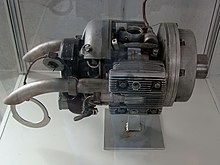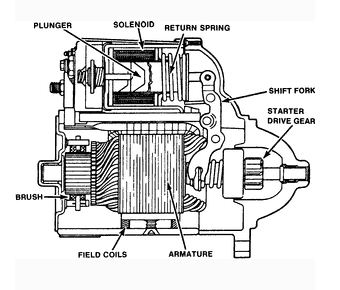Starter (engine)
In the event of a kickback, the reverse rotation of the engine could suddenly engage the starter, causing the crank to unexpectedly and violently jerk, possibly injuring the operator.Moreover, increasingly larger engines with higher compression ratios made hand cranking a more physically demanding endeavour.[3] In 1911, Charles F. Kettering, with Henry M. Leland, of Dayton Engineering Laboratories Company (DELCO), invented and filed U.S. patent 1,150,523 for an electric starter in America.One aspect of the invention lay in the realization that a relatively small motor, driven with higher voltage and current than would be feasible for continuous operation, could deliver enough power to crank the engine for starting.At the voltage and current levels required, such a motor would burn out in a few minutes of continuous operation, but not during the few seconds needed to start the engine.[5] The Dodge used a combined starter-generator unit, with a direct current dynamo permanently coupled by gears to the engine's crankshaft.A system of electrical relays allowed this to be driven as a motor to rotate the engine for starting, and once the starter button was released the controlling switchgear returned the unit to operation as a generator.The disadvantage of the design was that, as a dual-purpose device, the unit was limited in both its power as a motor and its output as a generator, which became a problem as engine size and electrical demands on cars increased.Since motorcycles usually had small engines and limited electrical equipment, as well as restricted space and weight, the Dynastart was a useful feature.The Ford Model T relied on hand cranks until 1919; during the 1920s, electric starters became near-universal on most new cars, making it easier for women and elderly people to drive.In many cases, cranks were used for setting timing rather than starting the engine as growing displacements and compression ratios made this impractical.Before Chrysler's 1949 innovation of the key-operated combination ignition-starter switch,[6] the starter was often operated by the driver pressing a button mounted on the floor or dashboard.When DC power from the starting battery is applied to the solenoid, usually through a key-operated switch (the "ignition switch"), the solenoid engages a lever that pushes out the drive pinion on the starter driveshaft and meshes the pinion with the starter ring gear on the flywheel of the engine.The sprag clutch arrangement would preclude the use of the starter as a generator if employed in the hybrid scheme mentioned above, unless modifications were made.The starter's electrical components are designed only to operate for typically under 30 seconds before overheating (by too-slow dissipation of heat from ohmic losses), to save weight and cost.When the starter motor begins turning, the inertia of the drive pinion assembly causes it to ride forward on the helix and thus engage with the ring gear.When the starter motor begins turning and the drive unit is forced forward on the helical shaft by inertia, it is latched into the engaged position.Direct-drive starters are almost entirely obsolete owing to their larger size, heavier weight and higher current requirements.[citation needed] Ford issued a nonstandard starter, a direct-drive "movable pole shoe" design that provided cost reduction rather than electrical or mechanical benefits.Hydraulic starters and the associated systems provide a sparkless, reliable method of engine starting over a wide temperature range.Pulling the release lever then applies the spring tension to the pinion, turning the ring gear to start the engine.Spring starters can be found in engine-generators and hydraulic power packs, and on lifeboat engines, with the most common application being backup starting system on seagoing vessels.





- Main housing (yoke)
- Freewheel and pinion gear assembly
- Armature
- Field coils with brushes attached
- Brush-carrier
- Solenoid





starter solenoidBendix driveinternal-combustion engineelectricpneumatichydraulicdiesel enginesfour-stroke engineStarter ring gearflywheelairshipNorbert RiedelJumo 004gunpowder cylindersone-directional slip or release provisionretard the sparkbackfiringbroken wristdislocated shouldercompression ratiosArnoldEast PeckhamEnglandCharles F. KetteringHenry M. Lelandcash registersCadillac Model ThirtyLanchestergeneratorshybrid vehiclesS.C.A.T.WolseleySunbeamModel 30-35direct currentdynamoSIBA Elektriktwo-stroke enginesFord Model TCitroën 2CVJunkers Jumo 004BMW 003auxiliary power unitChryslerFerguson TE20FreewheelpinionArmatureField coilsbrushesBrush-carrierSolenoidserieselectric motorstarting batterysprag clutchbackdriveohmic lossesChrysler Slant-6 enginegeartraingear reductionHighland Park, Michiganepicyclic gear trainspole shoeradialAir-start systemgas turbinetrucksair compressorair brakesdistributorhydraulic motorhydraulic fracturingpotential energyspringalternatorring gearengine-generatorslifeboat enginesBriggs & Strattonlawn mowersstop-start systemAircraft engine starterCoffman starterFlame-start systemHucks starterHybrid Synergy DriveList of auto partsVincent Hugo BendixGeorgano, G.N.Arthur Atwater KentElectric machinesAlternating currentPermanent magnetcommutatedBraking chopperCoil winding technologyCommutatorDamper windingDC injection brakingField coilSlip ringStatorWindingFlux switchingMagnetoLinearElectric generatorPM synchronous generatorInduction generatorDoubly fed (DFIG)Single-phase generatorMotorsAC motorInduction motorShaded-poleDahlander pole changing motorWound-rotor (WRIM)Linear inductionSynchronous motorRepulsionDC motorHomopolarBrushed DC electric motorBrushless DC electric motorUnipolar